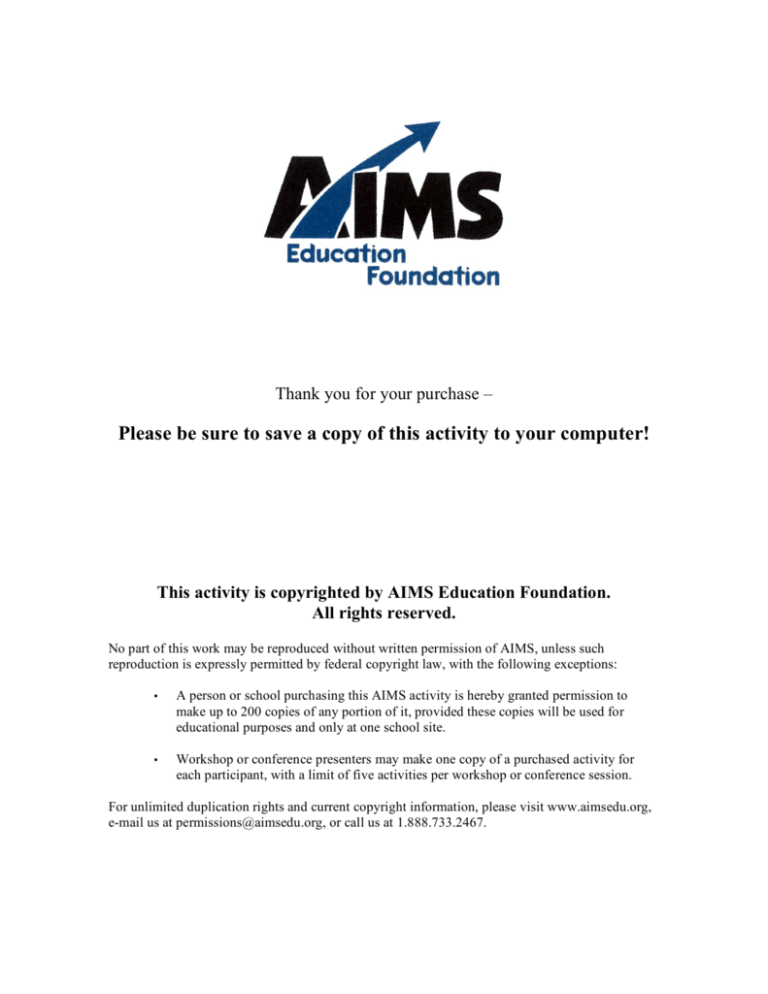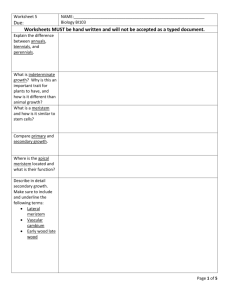
Thank you for your purchase –
Please be sure to save a copy of this activity to your computer!
This activity is copyrighted by AIMS Education Foundation.
All rights reserved.
No part of this work may be reproduced without written permission of AIMS, unless such
reproduction is expressly permitted by federal copyright law, with the following exceptions:
•
•
A person or school purchasing this AIMS activity is hereby granted permission to
make up to 200 copies of any portion of it, provided these copies will be used for
educational purposes and only at one school site.
Workshop or conference presenters may make one copy of a purchased activity for
each participant, with a limit of five activities per workshop or conference session.
For unlimited duplication rights and current copyright information, please visit www.aimsedu.org,
e-mail us at permissions@aimsedu.org, or call us at 1.888.733.2467.
Topic
Monocots and dicots
Background Information
Seeds are alike in some ways. They develop in the
ovary of a plant flower. They all contain a little plant
called an embryo. All seeds include food that helps
the tiny plant grow until it can make food of its own.
Seeds differ in sizes, shapes, and colors. They may
have different parts, depending upon the type of seed.
A corn seed, a monocotyledon (monocot), has a tiny
embryo inside it. However, the seed will not separate
into two parts when the seed coat is removed. The
endosperm food is stored around the embryo. There
is only one seed leaf (the cotyledon) which is quite
thin and not packed with food.
A bean seed, a dicotyledon (dicot), has a tiny
embryo tucked between two halves of the seed. These
two halves of a bean seed are cotyledons or seed
leaves. The cotyledons are filled with stored food.
The seed leaves are usually quite different in form
from the leaves that develop later.
Key Question
How do monocot and dicot seeds compare?
Learning Goals
Students will:
• dissect and compare a dicotyledon and monocotyledon seed; and
• identify the seed coat, the embryo, and the food
for the plant.
Guiding Documents
Project 2061 Benchmark
• A great variety of kinds of living things can be sorted
into groups in many ways using various features
to decide which things belong to which group.
NRC Standards
• Employ simple equipment and tools to gather data
and extend the senses.
• Each plant or animal has different structures that
serve different functions in growth, survival, and
reproduction. For example, humans have distinct
body structures for walking, holding, seeing, and
talking.
Monocotyledon
corn
wheat
rice
grasses
barley
Science
Life science
botany
seed dissection
lima beans
peanuts
almonds
peas
kidney beans
Management
1. Soak half of the seeds in water overnight.
2. Corn seeds are perhaps the easiest monocot seeds to
work with since they are larger than grass seeds.
3. It is easier to cut the corn seeds in half with scissors.
4. Provide a dry bean and corn seed and a soaked
bean and corn seed for each student or group of
students.
Integrated Processes
Observing
Comparing and contrasting
Collecting and recording data
Materials
For each group:
hand lens (or microscope)
seeds (lima, pinto, corn)
scissors
THE BUDDING BOTANIST
Dicotyledon
Procedure
Part One: Dicotyledon (Dicot) Seed
1. Give each student or group of students a dry bean
and corn seed and a soaked bean and corn seed.
2. Direct students to look at the exterior of the dry and
soaked bean seeds. Have them draw what they see
on the Part One recording sheet.
3. Tell students to carefully remove the seed coat of
the soaked bean. Ask, “Why do you think the seed
needs a coat?” [It protects the seed against injury
and drying out.]
17
© 2005 AIMS Education Foundation
4. Instruct students to try to remove the seed coat
from the dry bean seed. Ask them to describe how
the dry seed differs from the wet seed. [It is smaller
since the soaked seeds absorbed water.]
5. Have students use their thumbnails to carefully split
the seed. Does the seed split naturally into parts?
[Yes, there are two cotyledons; therefore, this bean
seed belongs to the dicotyledon group.]
6. Suggest students use their hand lenses to locate
the embryo (small plant) inside the seed. Have
them look for the leaves, stem, and rootstalk of the
embryo.
7. Guide students in finding the food storage area
(cotyledons).
8. Tell students to draw the inside of the seed including
the embryo, cotyledons, and seed coat.
9. Have students write at least five observations about
a dicot seed.
Connecting Learning
1. What is the difference between a seed that has been
soaked and one that is dry? [usually the soaked
seed is larger and the coat is soft and loose]
2. What does the inside of a dicotyledon seed
look like?
3. What do you see in both seeds that have been split
in two parts? [the embryo of the new plant]
4. What does the inside of a monocotyledon seed
look like?
5. Why is there an embryo in every seed?
6. How are dicot and monocot seeds different? [A
dicot seed has two seed leaves; the monocot has
one seed leaf.]
7. What is the economic importance of seeds?
8. What are you wondering now?
Extensions
1. Compare other dicotyledon seeds (peanuts, almonds, peas). Do they look the same? Do they
split into two halves?
2. Have students collect seeds from different kinds
of fruit. Have them identify each kind of seed as
monocot or dicot.
3. Bring in some samples of seeds and have students
classify them as monocot or dicot.
Bean Seed
embryo
seed coat
Curriculum Correlation
Language Arts
As a class, think of ten sentences giving facts about
dicotyledon and monocotyledon seeds.
cotyledon
food storage
Part Two: Monocotyledon (Monocot) Seed
1. Direct students to look at the exterior of the dry and
soaked corn seeds. Have them draw their observations on the Part Two recording sheet.
2. Tell students to remove the seed coat from the
soaked corn seed and try to split the seed into two
parts. (It won’t split.) Use scissors to cut it in half
lengthwise.
3. Have students use their hand lenses to locate the
embryo (small plant) inside the seed.
4. Ask students to draw the inside of the seed including
the embryo, endosperm, cotyledon, and seed coat.
5. Instruct students to write at least five observations
about a monocot seed.
Art
Have students use pictures and make a display of
foods that come from dicot seeds and that come from
monocot seeds.
Corn Seed
endosperm
food storage
cotyledon
embryo
seed coat
THE BUDDING BOTANIST
18
© 2005 AIMS Education Foundation
Key Question
How do monocot and
dicot seeds compare?
Learning Goals
• dissect and compare a dicotyledon and
monocotyledon seed; and
• identify the seed coat, the embryo, and
the food for the plant.
THE BUDDING BOTANIST
19
© 2005 AIMS Education Foundation
Part One
Make
accurate
observations.
Dicotyledon Seed
Remove the
seed coat
carefully.
1. Compare:
The dry seed coat
looks like this.
The soaked seed
coat looks like this.
2. Observe and Record:
Split your seed in half.
Use a magnifier to help
you see the details.
The seed coat looks like
this under a magnifier.
The inside of the dicot seed
looks like this.
Look for these parts:
embryo
seed
coat
cotyledon
(food storage)
3. Communicate: Write at least five observations of a dicot seed.
THE BUDDING BOTANIST
20
© 2005 AIMS Education Foundation
Part Two
Monocotyledon Seed
Make
accurate
observations.
Remove the
seed coat
carefully.
1. Compare:
The soaked seed
coat looks like this.
The dry seed coat
looks like this.
2. Observe and Record:
The seed coat looks like
this under a magnifier.
The inside of the monocot
seed looks like this.
Split your seed in half.
Use a magnifier to help
you see the details.
Look for these parts:
endosperm
(food storage)
cotyledon
embryo
seed coat
3. Communicate: Write at least five observations of a monocot seed.
THE BUDDING BOTANIST
21
© 2005 AIMS Education Foundation
1. What is the difference between a
seed that has been soaked and
one that is dry?
2. What does the inside of a
dicotyledon seed look like?
3. What do you see in both seeds that have
been split in two parts?
4. What does the inside of a monocotyledon
seed look like?
5. Why is there an embryo in every seed?
6. How are dicot and monocot seeds
different?
7. What is the economic importance of
seeds?
8. What are you wondering now?
THE BUDDING BOTANIST
22
© 2005 AIMS Education Foundation







